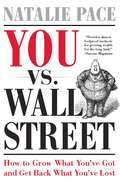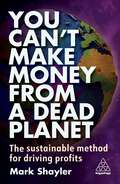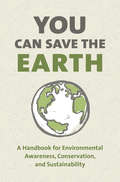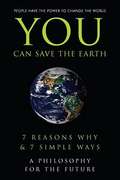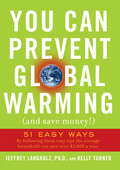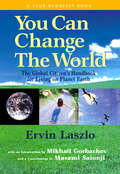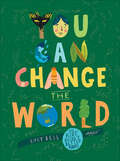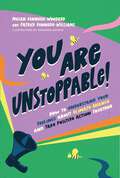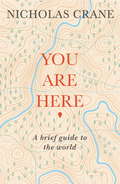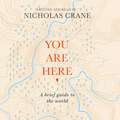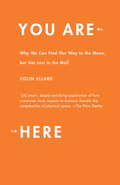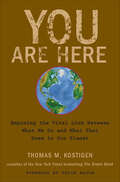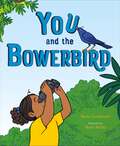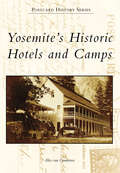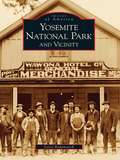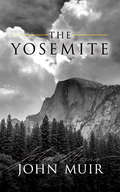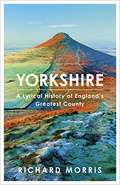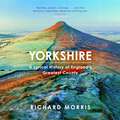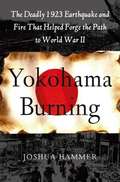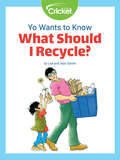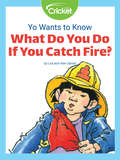- Table View
- List View
You vs. Wall Street
by Natalie PaceYou vs. Wall Street offers a sensible, easy-to-follow, yet powerful set of investing strategies for any would-be investor--from the complete novice to those with investing experience. You vs. Wall Street is a "must-read financial bible," and "just what some readers need to find themselves exponentially richer in the coming years," according to readers. How does an average investor win on Wall Street? Pace's own story began when she recognized the need for a better plan in 2000, when her Certified Financial Planner tried to sell her mutual funds anchored by the would-be bailouts of that day--Enron, Global Crossing and AOL. Pace averted colossal losses in her own stock portfolio by overweighting safe in 2000. She then developed easy-as-pie chart strategies that utilize the most effective investing strategies available, and learned how to identify which companies are bound for bailouts and which are bound for glory. Pace's trademarked Stock Report CardTM and Four Questions for picking the stars of an industry arm the everyday investor with key data that is available with a few simple clicks on the mouse. Learn how Stocks on Steroids can beautify your Buy My Own Island fund (formerly known as your retirement plan). You vs. Wall Street teaches you how to win on Wall Street in any market--bull or bear. Now is the time to choose wisdom over blind faith, to invest in winning companies and to whistle all the way to your local bailed out bank. * MASTER THE UNIQUE THREE-PART INVESTMENT PLAN * LEARN THE EARNINGS MAGIC OF STOCK REPORT CARDS * DISCOVER THE FOOLPPROOF GET RICH AND STAY RICH PROGRAM * FIND OUT HOW TO AVOID THE TOP ELEVEN INVESTING MISTAKES
You Can’t Make Money From a Dead Planet: The Sustainable Method for Driving Profits
by Mark ShaylerDoing good is no longer a luxury or a 'nice to have', it's a necessity.While businesses, both big and small, have undoubtedly caused the majority of our environmental and sustainability problems, only they can solve these issues at scale. You Can't Make Money from a Dead Planet looks at the challenges we face and shows how business needs to change in order to be the driver of the solution. Bestselling author and sustainability strategist Mark Shayler explains why there is no contradiction between being profitable and doing the right thing for the planet and doing the right thing for your customers. Providing the insights, the enthusiasm and the tools to align your business with sustainability, it blends explanations of the challenges that we face, with stories from those business that have excelled in sustainability. Exploring current sustainability approaches and trends including net-zero, circular economy, ESG, B-Corps, zero waste and environmental management systems, You Can't Make Money From a Dead Planet explains, debunks and helps you navigate the sustainable agenda while growing your business.
You Can Save the Earth, Revised Edition: A Handbook for Environmental Awareness, Conservation and Sustainability
by Sean K. SmithFinally—a hopeful book which empowers us to make the choices we need to make...not out of fear but out of love for ourselves, our Earth, and each other. In its long-awaited revised edition, You Can Save the Earth, Revised Edition provides even more reasons and ways to pay attention to our planet by being stewards to sustainability. Including the latest information from climate studies, international policy and critical ecological issues, You Can Save the Earth, Revised Edition brings the same level of solution-centered discourse to the next level. Includes inspirational quotes from influential environmentalists and thought leaders including Al Gore, Jacques-Yves Cousteau, Martin Luther King, Jr., Mother Teresa, Walt Whitman, Henry David Thoreau, Howard Zinn, E.F. Schumacher, William Shakespeare, Ayn Rand, and Mahatma Gandhi.You Can Save the Earth, Revised Edition is the perfect book to pick up for your friends, your office, your home, and yourself. While many books on sustainability and climate change focus only on disasters and what has gone wrong–what we have lost–this one takes a new tack. You Can Save the Earth focuses on real-life, simple solutions to many of our global problems, and emphasizes steps that can be taken on an individual basis or on a local level to promote environmental awareness and conservation.A portion of the proceeds from your purchase goes to good, designated for non-profit organizations specifically active in addressing the issues that face the survival of the Earth, including: Wildlife Conservation Society National Audubon Society Save the Whales Sierra Club Waterkeeper AllianceThe Nature Conservancy Cousteau SocietyEarth Corps Go Green InitiativeNational Resources Defense Council People and PlanetThe Mountain Institute The Rainforest Foundation-US
You Can Save The Earth: A Philosophy For The Future
by June EdingWith a fresh, philosophical approach, this work outlines simple and rewarding ways individuals can take action for the good of the Earth--and themselves.
You Can Prevent Global Warming (and Save Money!): 51 Easy Ways
by Jeffrey Langholz Kelly TurnerNo-cost and low-cost tips to save thousands of dollars—and reduce carbon emissions that are wreaking havoc on the climate. There’s plenty of public concern about global warming’s effects—mounting natural disasters, mass migrations, crop failures, and more. This new edition of the classic guide shows how to channel that public concern into positive action. It’s filled with simple everyday things you can do to minimize future global warming—and as a bonus, save money at the same time.Whether you’re one of the nearly three-quarters of Americans who consider themselves environmentalists or you’re interested in practical ways to reduce household expenses—or both!—you’ll find hundreds of straightforward tips and suggestions to start putting into practice today.
You Can Prevent Global Warming (and Save Money!): 51 Easy Ways
by Jeffrey Langholz Kelly TurnerNo-cost and low-cost tips to save thousands of dollars—and reduce carbon emissions that are wreaking havoc on the climate. There’s plenty of public concern about global warming’s effects—mounting natural disasters, mass migrations, crop failures, and more. This new edition of the classic guide shows how to channel that public concern into positive action. It’s filled with simple everyday things you can do to minimize future global warming—and as a bonus, save money at the same time.Whether you’re one of the nearly three-quarters of Americans who consider themselves environmentalists or you’re interested in practical ways to reduce household expenses—or both!—you’ll find hundreds of straightforward tips and suggestions to start putting into practice today.
You Can Change The World
by Ervin LaszloYou Can Change the World: The Global Citizen's Handbook for Living on Planet Earth should be required reading for anyone who cares about the future of the planet. Written by renowned scientist, futurist and Club of Budapest founder Ervin Laszlo, You Can Change the World answers two pertinent questions-first, what is at the root of all the conflict and crisis in today's world? And second, what can actually be done to move toward a world where we can live in peace, without marginalizing and killing each other and destroying the environment?A handbook that urges readers to become global citizens who aspire to live responsibly on this precious but highly exploited and crisis-prone planet, You Can Change the World provides a simple and basic message: in today's world it is neither wealth nor power, nor the control of territory and technology that make the crucial difference. How we think and act shapes our present and decides our future.
You Can Change the World: The Kids' Guide to a Better Planet
by Lucy BellYou Can Change the World empowers kids to make changes in their lives and communities with the powerful message that anyone can make a difference in the world. This colorfully illustrated book is packed with information, ideas, and activities for everyday sustainability—like mending clothes, composting, and avoiding single-use plastics. Interspersed throughout are features on children around the globe who are making a difference, such as Greta Thunberg or Solli Raphael, reminding kids that ordinary people can spark extraordinary change.
You Can Change the World: The Global Citizen's Handbook for Living on Planet Earth
by Mikhail Gorbachev Masami Saionji Ervin LaszloYou Can Change the World: The Global Citizen's Handbook for Living on Planet Earth should be required reading for anyone who cares about the future of the planet. Written by renowned scientist, futurist and Club of Budapest founder Ervin Laszlo, You Can Change the World answers two pertinent questions-first, what is at the root of all the conflict and crisis in today's world? And second, what can actually be done to move toward a world where we can live in peace, without marginalizing and killing each other and destroying the environment?A handbook that urges readers to become global citizens who aspire to live responsibly on this precious but highly exploited and crisis-prone planet, You Can Change the World provides a simple and basic message: in today's world it is neither wealth nor power, nor the control of territory and technology that make the crucial difference. How we think and act shapes our present and decides our future.
You Are Unstoppable!: How to Understand Your Feelings about Climate Change and Take Positive Action Together
by Megan Kennedy-Woodard Dr. Patrick Kennedy-WilliamsFeeling sad, scared or angry about climate change? You are not alone. It means that you care. This book helps you harness the power of these emotions and turn them into climate action that will leave you feeling connected, motivated, and powerfully optimistic.You will learn how to:· notice and manage your eco-emotions· become a self-care champion· turn climate anxiety into climate action· inspire others to make changes· and most importantly, enjoy the climate work you do!Your journey starts today. You are unstoppable!"
You Are Here: A Brief Guide to the World
by Nicholas CraneOne word binds us all: geography. We are all geographers, human beings who care about the places we think of as 'home' - our habitat. And yet we have lost touch with the connection between our actions and the state of the planet that we all share. We need a new narrative that restores the connections between humanity and the Earth. We are being confronted by a daily barrage of geographical stories on climate change, geopolitics, population growth, migration, dwindling resources, polluted oceans and natural hazards. These are planetary concerns affecting all people and all places. They are challenges which can be addressed through geography.In this short but powerful book, Nicholas Crane makes the compelling case that never has geography been so important. On this finite orb, with its battered habitat, sustained in dark space by a thin, life-giving atmosphere, we have reached a point in our collective geographical journey where knowledge is the best guarantor of the future.[NOTE: published in hardback as YOU ARE HERE]
You Are Here: A Brief Guide to the World
by Nicholas CraneOne word binds us all: geography. We are all geographers, human beings who care about the places we think of as 'home' - our habitat. And yet we have lost touch with the connection between our actions and the state of the planet that we all share. We need a new narrative that restores the connections between humanity and the Earth. We are being confronted by a daily barrage of geographical stories on climate change, geopolitics, population growth, migration, dwindling resources, polluted oceans and natural hazards. These are planetary concerns affecting all people and all places. They are challenges which can be addressed through geography.In this short but powerful book, Nicholas Crane makes the compelling case that never has geography been so important. On this finite orb, with its battered habitat, sustained in dark space by a thin, life-giving atmosphere, we have reached a point in our collective geographical journey where knowledge is the best guarantor of the future.[NOTE: published in hardback as YOU ARE HERE]
You Are Here: A Brief Guide to the World
by Nicholas CraneOne word binds us all: geography. We are all geographers, human beings who care about the places we think of as 'home' - our habitat. And yet we have lost touch with the connection between our actions and the state of the planet that we all share. We need a new myth, a new narrative that restores the connections between humanity and the Earth.We are being confronted by a daily barrage of geographical stories on climate change, geopolitics, population growth, migration, dwindling resources, polluted oceans and natural hazards. These are planetary concerns affecting all people and all places. They are geographical challenges which can be addressed through geography.In this distillation of a lifetime's work, Nicholas Crane makes the compelling case that never has geography been so important. On this finite orb, with its battered habitat, sustained in dark space by a thin, life-giving atmosphere, we have reached a point in our collective geographical journey where knowledge is the best guarantor of the future.Written and read by Nicholas Crane(p) Orion Publishing Group 2018
You Are Here: Why We can Find Our Way to the Moon but Get Lost in The Mall
by Colin EllardA fascinating exploration of human navigation, both feat and foible, in the age of GPS and GoogleEarth We live in a world crowded by street signs and arrows. With the click of a computer mouse we can find exact directions to just about anywhere on earth, and with a handheld GPS we can find our precise latitude and longitude, even in the remotest of places. But despite all our advancements, we still get lost in the mall, can’t follow directions to a friend’s house and, on camping expeditions, take wrong turns that can mean the difference between life and death. Many other species, however, have an innate sense of direction. Ants display surprisingly sophisticated behavior, traveling great distances without wasting a step. Monarch butterflies and migrating songbirds pilot even greater expanses, thousands of kilometers in some instances, to targets that they might never even have seen before. A homing pigeon can be driven halfway across a continent in a lightproof box and then, on release, find its way—unerringly-back to its loft. What is truly amazing, though, is that humans, the only animal that has come close to understanding how some of these magnificent navigational feats are performed, are rendered helpless by dense bush or even an unexpected turn in a maze of cubicles. InYou Are Here, psychologist Colin Ellard explains how, over centuries of innovation, we have lost our instinctive ability to find our way, as we traverse vast distances in mere hours in luxurious comfort. Some cultures, such as the Inuit, retain the ability to navigate huge expanses of seemingly empty space, as their survival depends on it, but the rest of us have been so conditioned by our built-up world that we don’t really know how to get from point A to point B. Drawing on his exhaustive research, Ellard illuminates this disconnect from our world with great clarity and explains what it means, not just for our forays into the wilderness but for how we construct our cities, our workplaces, and even our homes and virtual worlds. Architects and city planners, he suggests, need to consider human behavior when designing human environments, and we all need to recognize that we are part of, not isolated from, the space around us.
You Are Here: Exposing the Vital Link Between What We Do and What That Does to Our Planet
by Thomas M. KostigenIn this groundbreaking book, the New York Times bestselling coauthor of The Green Book Thomas M. Kostigen reveals the vital missing link in today's environmental crisis: how we as individuals are connected to the most tenuous geography on the planet. Despite the recent prominence of "green" issues in the news, the direct relationship between our actions and the earth is too often ignored. But the seemingly insignificant things we do every day have the power to literally alter the landscape in the ongoing battle to resuscitate the planet.
You and the Bowerbird
by Maria GianferrariFollow the Satin Bowerbird as he searches for the perfect welcome mat for his new home, in this delightfully colorful and action-packed nonfiction tale by award winning author Maria Gianferrari, and illustrated by comic-star Maris Wicks. Just on the edge of the rainforest, Between your house and the trees, Bowerbirds collect, pillage, and steal! They swoop through the air, And creep around the forest floor, Searching for pretty objects everywhere…
Yoshi, Sea Turtle Genius: A True Story about an Amazing Swimmer
by Lynne CoxIn this picture book that is both heartwarming and exciting, join Yoshi, a sea turtle, on her remarkable journey as she swims farther than any animal in recorded history—23,000 miles!—to return to the beach where she first hatched, to lay her own eggs. <p><p>Inside every loggerhead turtle is genius: the ability to find their first home, no matter how far away. Follow one, from her birth on a beach in Australia…to her trip across an ocean filled with sharks and seahorses and much more…to her rescue from a net by a fisherman, who names her Yoshi…to her rehabilitation at an aquarium…to her record-breaking swim across the Indian Ocean to the beach on which she hatched, to lay her eggs. <p><p>Written by Lynne Cox, also a record-breaking swimmer, here is the true story of a sea turtle who swam the longest distance of any animal in recorded history.
Yosemite's Historic Hotels and Camps (Postcard History)
by Alice Van OmmerenYosemite National Park is a place of extraordinary natural beauty with renowned waterfalls, spectacular granite rock formations, and serene meadows. Although indigenous peoples already inhabited Yosemite, settlers of European descent found their way there beginning in 1851. To serve the steady growth of tourists and visitors, lodging and accommodations have always been central to the park's history. The popularity of postcards starting in the early 1900s and lasting several decades coincided with the growth of the park's hotels and camps, transportation, and entertainment. This book of vintage postcards illustrates and chronicles those places and events. It provides visitors with an understanding and appreciation for the unique and diverse places made available to tourists throughout Yosemite's history.
Yosemite National Park and Vicinity
by Leroy RadanovichThe astonishing scenery of Yosemite National Park is known throughout the world, primarily for the soaring granite outcroppings and graceful waterfalls around Yosemite Valley. But this park is much larger than just the valley. Relatively few visitors get to experience Yosemite's vast expanses, whether south to Wawona and Fish Camp or east to White Wolf and Tuolumne Meadows. Indeed, it was John Muir's efforts to protect the meadows and hills around the valley that ultimately led to the establishment of Yosemite National Park in 1890. The state park, which had been established in 1863 and consisted of Yosemite Valley and the Mariposa Grove of Big Trees, was added to the federal park in 1913.
The Yosemite: Illustrated Edition (Mobi Classics Series)
by John MuirAn essential companion for visitors, this book by the famed conservationist offers informed appraisals of Yosemite's plant and animal life and exudes an almost mystical love for its natural beauty.
Yorkshire: A lyrical history of England's greatest county
by Richard MorrisYorkshire is 'a continent unto itself', a region where mountain, plain, coast, downs, fen and heath lie close. By weaving history, family stories, travelogue and ecology, Richard Morris reveals how Yorkshire took shape as a landscape and in literature, legend and popular regard. The result is a fascinating and wide-ranging meditation on Yorkshire and Yorkshireness, told through the prism of the region's most extraordinary people and places.
Yorkshire: A lyrical history of England's greatest county
by Richard MorrisYorkshire is 'a continent unto itself', a region where mountain, plain, coast, downs, fen and heath lie close. By weaving history, family stories, travelogue and ecology, Richard Morris reveals how Yorkshire took shape as a landscape and in literature, legend and popular regard. The result is a fascinating and wide-ranging meditation on Yorkshire and Yorkshireness, told through the prism of the region's most extraordinary people and places.
Yokohama Burning: The Deadly 1923 Earthquake and Fire that Helped Forge the Path to World War II
by Joshua HammerYokohama Burning is the story of the worst natural disaster of the twentieth century: the earthquakes, fires, and tsunamis of September 1923 that destroyed Yokohama and most of Tokyo and killed 140,000 people during two days of horror. With cinematic vividness and from multiple perspectives, acclaimed Newsweek correspondent Joshua Hammer re-creates harrowing scenes of death, escape, and rescue. He also places the tumultuous events in the context of history and demonstrates how they set Japan on a path to even greater tragedy. At two minutes to noon on Saturday, September 1, 1923, life in the two cities was humming along at its usual pace. An international merchant fleet, an early harbinger of globalization, floated in Yokohama harbor and loaded tea and silk on the docks. More than three thousand rickshaws worked the streets of the port. Diplomats, sailors, spies, traders, and other expatriates lunched at the Grand Hotel on Yokohama's Bund and prowled the dockside quarter known as Bloodtown. Eighteen miles north, in Tokyo, the young Prince Regent, Hirohito, was meeting in his palace with his advisers, and the noted American anthropologist Frederick Starr was hard at work in his hotel room on a book about Mount Fuji. Then, in a mighty shake of the earth, the world as they knew it ended. When the temblor struck, poorly constructed buildings fell instantly, crushing to death thousands of people or pinning them in the wreckage. Minutes later, a great wall of water washed over coastal resort towns, inundating people without warning. Chemicals exploded, charcoal braziers overturned, neighborhoods of flimsy wooden houses went up in flames. With water mains broken, fire brigades could only look on helplessly as the inferno spread. Joshua Hammer searched diaries, letters, and newspaper accounts and conducted interviews with nonagenarian survivors to piece together a minute-by-minute account of the catastrophe.
Yo Wants to Know: What Should I Recycle?
by Lea Daniel Alan DanielYo helps his father recycle garbage and learns what types of trash go into the recycling bin. Yo learns his fleece vest is made of plastic and that special factories recycle the plastic and melt it down into new things like toys and his favorite fleece vest! Can you guess which trash goes into the blue bins? Yo wants to surprise his mother with a special present–knowing how to recycle!
Yo Wants to Know: What Do You Do If You Catch Fire?
by Lea Daniel Alan DanielYo knows just what to do if he catches fire–stop drop and roll! Yo visits the fire station and learns how to put out dangerous flames by rolling around on the ground. He learns that running and waving your arms makes fire get bigger. Yo practices what to do and what not to do in case of fire. Would you know what to do to protect yourself? Have you ever visited a fire station?
